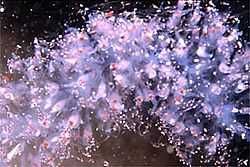Apolemia uvaria
| Apolemia uvaria | |
|---|---|
 | |
| Scientific classification | |
| Kingdom: | Animalia |
| Phylum: | Cnidaria |
| Class: | Hydrozoa |
| Order: | Siphonophorae |
| Suborder: | Physonectae |
| Family: | Apolemiidae |
| Genus: | Apolemia |
| Species: | A. uvaria |
| Binomial name | |
| Apolemia uvaria (Lesueur, 1815) | |

Apolemia uvaria, commonly known as string jellyfish, barbed wire jellyfish,[1] and long stringy stingy thingy,[2] is a siphonophore in the family Apolemiidae.[3]
String jellyfish are colonial animals which may reach 3 m in total length and have a diameter of 2–5 cm. The colony is formed of a central string, bearing groups of pink and white tentacles which clump together or extend. The whole colony has a gas float at the front and a set of swimming bells.[4] This colonial animal is pelagic and is found in oceans worldwide in midwater.[4] These ocean predators act like drift nets, spreading their tentacles to catch plankton. The tentacles give a painful sting and are best avoided.[2][4]
References
- ↑ Jones, Georgina. A field guide to the marine animals of the Cape Peninsula. SURG, Cape Town, 2008. ISBN978-0-620-41639-9
- ↑ 2.0 2.1 Staff, Te Ara, The Encyclopedia of New Zealand. http://www.teara.govt.nz/en/corals-anemones-and-jellyfish/page-1 Accessed 16 Sept 2013
- ↑ http://marinespecies.org/aphia.php?p=taxdetails&id=135497 accessed 8 September 2013
- ↑ 4.0 4.1 4.2 Wrobel D. & Mills C. 2003. Pacific Coast Pelagic Invertebrates: a guide to the common gelatinous animals. Sea Challengers. ISBN 0-930118-23-5
| Wikimedia Commons has media related to Apolemia uvaria. |